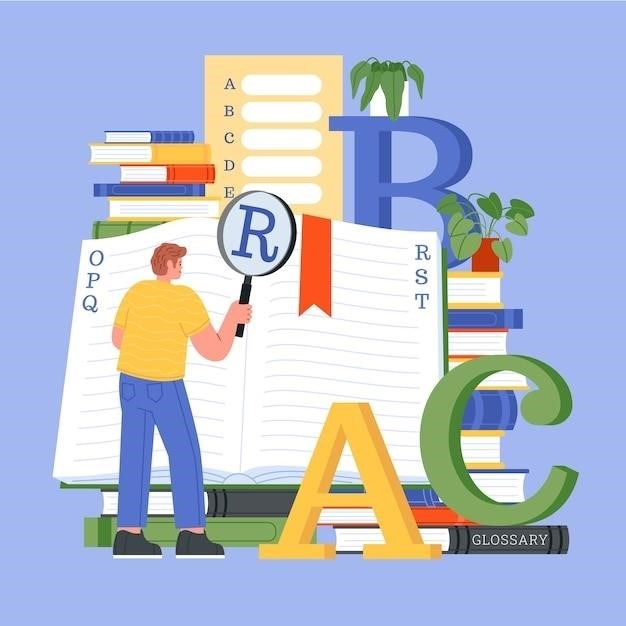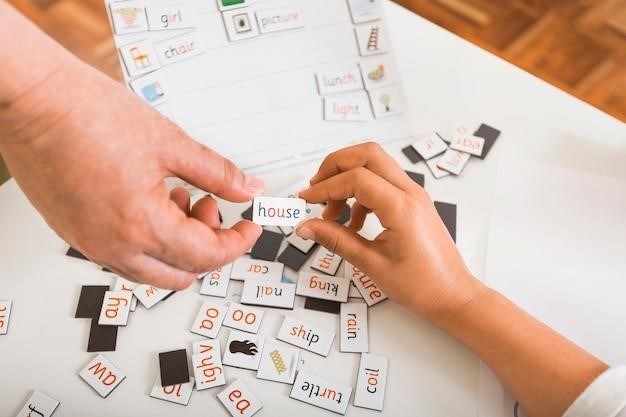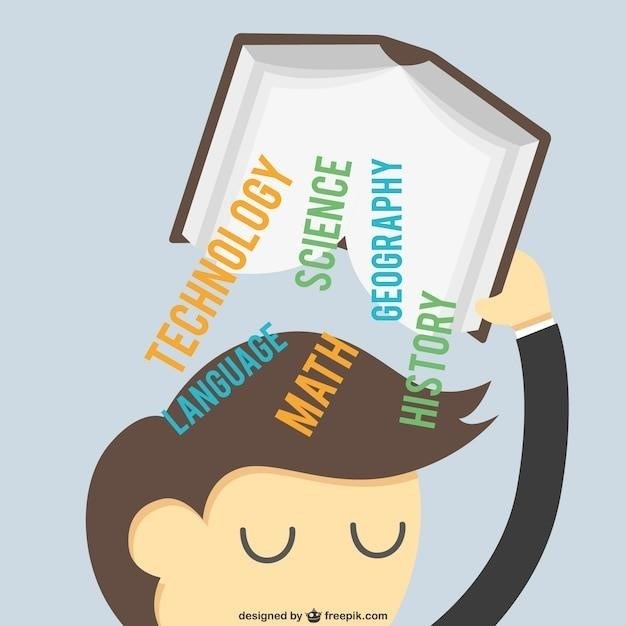science of reading vocabulary instruction

Science of Reading Vocabulary Instruction⁚ A Comprehensive Overview
This overview explores the science-backed methods for effective vocabulary instruction, emphasizing its crucial role in reading comprehension. We’ll examine explicit instruction techniques, contextual learning strategies, and engaging activities to foster vocabulary growth and deepen reading understanding, aligning with the latest research in literacy.
The Importance of Vocabulary in Reading Comprehension
Vocabulary knowledge is fundamentally intertwined with reading comprehension. A robust vocabulary acts as a cornerstone for successful reading, enabling students to unlock meaning from text. Limited vocabulary directly hinders comprehension, creating a barrier to accessing information and understanding complex ideas presented in written material. The National Reading Panel (2000) highlighted vocabulary instruction as a critical component of effective reading instruction, underscoring its significant impact on reading success. Students with strong vocabularies demonstrate greater reading fluency and comprehension skills. They can more readily decode unfamiliar words, infer meaning from context, and understand nuanced language. Conversely, a weak vocabulary restricts a reader’s ability to grasp the subtleties of text, hindering their overall comprehension and enjoyment of reading. Building a rich vocabulary is not merely about memorizing definitions; it’s about understanding word relationships, multiple meanings, and the nuances of language. This deep understanding allows for better interpretation, critical analysis, and overall comprehension of written texts across different subjects and genres. Explicit and systematic vocabulary instruction is therefore vital for fostering strong readers who are equipped to comprehend and engage with the diverse and complex world of written language.
Effective Vocabulary Instruction⁚ Key Principles and Strategies
Effective vocabulary instruction goes beyond rote memorization; it focuses on rich meaning and word relationships. Key principles include emphasizing connections between words (e.g;, through common prefixes, suffixes, or roots), fostering word consciousness (an awareness and appreciation for words), and providing multiple opportunities for students to use new vocabulary in various contexts (reading, writing, speaking). Strategies such as using student-friendly definitions, illustrating word meanings through visuals or real-world examples, and incorporating engaging word play and games are crucial. Explicit instruction is paramount, ensuring students understand not just definitions but also the nuances of word usage. Contextual learning, where students encounter words in meaningful reading experiences, is also important. However, relying solely on incidental learning is insufficient; direct instruction is necessary for mastery of key vocabulary. Effective instruction differentiates instruction to meet diverse learners’ needs, providing additional support for struggling students while challenging advanced learners. Regular review and reinforcement activities help solidify vocabulary learning over time, preventing rapid forgetting; A multi-sensory approach, engaging multiple learning styles through various activities, enhances retention and understanding. The ultimate goal is to develop students’ vocabulary breadth and depth, empowering them to become confident and effective communicators.

Explicit Vocabulary Instruction⁚ Methods and Techniques
Explicit vocabulary instruction involves directly teaching specific words and their meanings, moving beyond implicit learning through reading alone. Effective methods include providing student-friendly definitions, avoiding overly complex or technical language. Visual aids, such as illustrations, photographs, or real-world objects, enhance understanding and memory. Connecting new words to students’ prior knowledge through examples and analogies facilitates comprehension. Activities like semantic mapping, where students visually organize words based on their relationships, strengthen connections between words and concepts. The use of mnemonics, memory aids that link new words to memorable images or phrases, can significantly improve retention. Repeated exposure to the target vocabulary in various contexts (reading, writing, speaking) is essential. Incorporating games and interactive activities, such as vocabulary bingo or word association games, increases engagement and reinforces learning. Regular review and practice, spaced over time, solidify learning and prevent forgetting. Differentiation is key, adapting instruction to meet the diverse needs of learners; providing extra support for struggling students while challenging advanced learners. Assessment, through various methods such as quizzes, games, and writing assignments, helps gauge student understanding and informs future instruction. The goal is to foster both breadth and depth of vocabulary knowledge, enabling students to use words accurately and effectively in their communication.
Contextual Learning and Vocabulary Acquisition
Contextual learning leverages the power of surrounding text to aid vocabulary acquisition. Instead of isolating words, this approach emphasizes understanding word meaning within the context of sentences, paragraphs, and the entire text. Students learn to infer word meanings based on surrounding clues, such as definitions, examples, synonyms, and antonyms provided within the text itself. This promotes deeper understanding and better retention than rote memorization. Strategies like close reading, where students carefully analyze text segments to decipher word meaning, are highly effective. Encouraging students to actively engage with the text, using strategies like questioning, predicting, and summarizing, enhances their ability to deduce word meaning from context. Teachers can model effective strategies for using context clues, highlighting different types of contextual information and guiding students in their analysis. Providing opportunities for students to discuss their interpretations and share their reasoning further strengthens comprehension. This approach fosters independent vocabulary learning, empowering students to become active constructors of their own word knowledge. While explicit instruction remains important, contextual learning complements it by promoting a more natural and intuitive understanding of language in action. It encourages students to become strategic readers, adept at using contextual clues to unlock the meaning of unfamiliar words.
Engaging Word Play and Games for Vocabulary Development
Incorporating playful activities significantly boosts vocabulary acquisition. Games transform learning into an enjoyable experience, motivating students to actively engage with words. Word association games, where students connect words based on meaning or sound, stimulate critical thinking and build vocabulary networks. Categorization activities, requiring students to group words based on shared characteristics, enhance understanding of semantic relationships. Creating word maps or semantic webs visually represents these connections, aiding comprehension and retention. Interactive online games and apps can add a digital dimension, providing engaging and accessible learning experiences. These tools often incorporate gamification elements like points, rewards, and competition, fostering motivation and engagement. Simple word games like “I Spy” or “20 Questions,” adapted to focus on specific vocabulary, can be easily integrated into the classroom. Students can create their own games, designing activities that reinforce learned vocabulary and challenge their peers. These interactive exercises encourage collaborative learning, providing opportunities for students to share their knowledge and learn from each other. The playful nature of these activities reduces the pressure associated with traditional vocabulary learning, making the process more enjoyable and effective.

Applying the Science of Reading to Science Vocabulary
Effective science vocabulary instruction mirrors the principles of the Science of Reading. Explicit instruction, rich contextual learning, and engaging activities are crucial for building a strong foundation in science literacy.
Teaching Science Vocabulary⁚ Best Practices
Effective science vocabulary instruction goes beyond simple definitions; it necessitates a multifaceted approach rooted in the principles of the Science of Reading. Prioritize rich, contextualized learning experiences. Instead of isolated vocabulary lists, integrate new terms within engaging science activities, experiments, and discussions. Encourage students to actively use the vocabulary in their writing and speaking. Provide multiple opportunities for repeated exposure, using various modalities like visual aids, hands-on activities, and interactive games. Connect new vocabulary to students’ prior knowledge and existing word networks to build stronger semantic connections. Explicitly teach word-learning strategies, such as morphemic analysis (breaking words into parts) and using context clues. Regularly assess students’ understanding, not just through rote memorization, but through application in authentic contexts. Consider the use of graphic organizers, concept maps, and other visual aids to support vocabulary acquisition and retention. Remember, the ultimate goal is to foster deep understanding and fluent use of science vocabulary, empowering students to effectively communicate and reason within the scientific domain.
Connecting Science Vocabulary to Prior Knowledge
Building upon students’ pre-existing knowledge is paramount for effective science vocabulary instruction. Begin by activating prior knowledge through brainstorming, discussions, or quick writes related to the upcoming science topic. Encourage students to share what they already know, fostering a sense of community and shared understanding. Use graphic organizers, such as KWL charts (Know, Want to know, Learned), to visually represent students’ existing knowledge and guide their learning journey. Make explicit connections between new vocabulary and familiar concepts or words. For example, if introducing “photosynthesis,” relate it to familiar words like “photo” (light) and “synthesis” (making). Use analogies and metaphors to create bridges between the unfamiliar and the known, making abstract concepts more accessible. Encourage students to create their own analogies and metaphors, deepening their understanding and strengthening memory retention. Incorporate real-world examples and relatable scenarios to illustrate the meaning and application of new vocabulary terms. By actively connecting new science vocabulary to students’ prior experiences and existing knowledge, you build a strong foundation for comprehension and long-term retention.
Integrating Vocabulary Instruction Across Disciplines
Effective vocabulary instruction transcends isolated subjects; it thrives on cross-curricular integration. Seamlessly weaving science vocabulary into other subjects strengthens comprehension and reinforces learning. For instance, when studying ecosystems in science, integrate related vocabulary into language arts through descriptive writing or discussions. In math, utilize science terms when solving word problems involving measurements or data analysis. History lessons can incorporate scientific advancements and the vocabulary related to those discoveries. This interconnected approach emphasizes the relevance and practicality of science vocabulary, demonstrating its application in various contexts. Encourage students to use science vocabulary in their writing across subjects, fostering fluency and deeper understanding. Regularly review and reinforce vocabulary across disciplines, employing diverse methods such as games, discussions, and creative projects. This holistic approach maximizes vocabulary acquisition, enhances critical thinking, and promotes a deeper understanding of the interconnectedness of knowledge.
Assessing Vocabulary Learning and Growth
Formative assessment is crucial for tracking vocabulary acquisition and adjusting instruction. Regular low-stakes quizzes, quick checks, and informal observations during class discussions provide ongoing feedback. These assessments should gauge both receptive (understanding) and productive (using) vocabulary knowledge. Consider using varied assessment methods, such as vocabulary matching exercises, fill-in-the-blank activities, short answer questions requiring definition and use in context, and even creative projects demonstrating understanding. Summative assessments, like unit tests or projects, offer a more comprehensive evaluation of vocabulary mastery at the end of a learning period. Analyzing student performance on these assessments helps identify areas where additional support is needed and informs future instructional choices. The use of technology can also enhance assessment, allowing for quick and efficient data collection, analysis, and individualized feedback. Remember to celebrate successes and use assessment data to refine teaching strategies and provide differentiated instruction to meet individual student needs, fostering a growth mindset and promoting continued vocabulary development.
Leave a Reply
You must be logged in to post a comment.